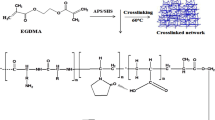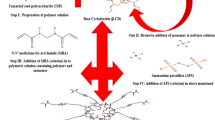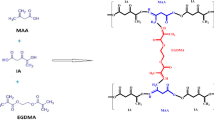Abstract
The prime objective of the present study was to develop novel colon targeting xanthan gum/polyvinylpyrrolidone-co-poly acrylic acid hydrogels for controlled delivery of 5-fluorouracil at colon-specific site by combining the properties of natural and synthetic polymers. Xanthan gum (XG) and polyvinylpyrrolidone (PVP) polymer have been chemically cross-linked with acrylic acid (AA) monomer using ethylene glycol dimethacrylate and ammonium per sulfate/sodium hydrogen sulfite as a cross-linker and initiator, respectively. Different proportions of XG, PVP, acrylic acid and ethylene glycol dimethacrylate were blended with each other to fabricate pH-sensitive hydrogels by free radical polymerization. SEM, FTIR, TGA, DSC, XRD and sol−gel fraction analysis were carried out for characterization and structural analysis of polymeric system. pH-responsive behavior of fabricated hydrogels was investigated by performing swelling studies and in vitro drug release studies at both pH 1.2 and pH 7.4. Toxicity studies were performed on rabbits to evaluate cytotoxicity and biocompatibility. TGA and DSC confirmed that formulations were thermodynamically stable, while FTIR, SEM and XRD revealed the successful grafting of components. By increasing the content of polymer, monomer and cross-linker, gel fraction was found to be increased. Swelling capacity of hydrogels increases with the increase in concentration of monomer, while swelling capacity tends to decreases with the increase in concentration of cross-linker and polymer in hydrogel composition. pH sensitivity of hydrogels was confirmed by swelling dynamic and drug release behavior in simulated gastrointestinal fluids. Toxicity studies confirmed that hydrogels were non-toxic. Drug release kinetics revealed the controlled release pattern of 5-fluorouracil in developed polymeric network. Cross-linked XG/PVP-co-poly (AA) hydrogels can be used as promising candidate for controlled delivery of 5-FU for prolonged treatment period at colon-specific site.








Similar content being viewed by others
References
Ganji F, Vasheghani-Farahani E (2009) Hydrogels in controlled drug delivery systems. Iran Polym J 18:63–88
Ahmed EM (2015) Hydrogel: preparation, characterization, and applications: a review. J Adv Res 6:105–121
Gupta P, Vermani K, Garg S (2002) Hydrogels: from controlled release to pH-responsive drug delivery. Drug Discov Today 7:569–579
Hennink WE, van Nostrum CF (2012) Novel crosslinking methods to design hydrogels. Adv Drug Deliv Rev 64:223–236
Peppas N, Bures P, Leobandung W, Ichikawa H (2000) Hydrogels in pharmaceutical formulations. Eur J Pharm Biopharm 50:27–46
Lee SC, Kwon IK, Park K (2013) Hydrogels for delivery of bioactive agents: a historical perspective. Adv Drug Deliv Rev 65:17–20
Banerjee S, Ray S, Maiti S, Sen KK, Bhattacharyya U, Kaity S, Ghosh A (2010) Interpenetrating polymer network (IPN): a novel biomaterial. Int J Appl Pharm 2:28–34
Lin C-C, Metters AT (2006) Hydrogels in controlled release formulations: network design and mathematical modeling. Adv Drug Deliv Rev 58:1379–1408
Dragan ES (2014) Design and applications of interpenetrating polymer network hydrogels. A review. Chem Eng J 243:572–590
Wichterle O, Lim D (1960) Hydrophilic gels for biological use. Nature 185:117
Shalviri A, Liu Q, Abdekhodaie MJ, Wu XY (2010) Novel modified starch–xanthan gum hydrogels for controlled drug delivery: synthesis and characterization. Carbohydr Polym 79:898–907
Talukdar M, Kinget R (1995) Swelling and drug release behaviour of xanthan gum matrix tablets. Int J Pharm 120:63–72
Mukhopadhyay P, Sarkar K, Bhattacharya S, Bhattacharyya A, Mishra R, Kundu P (2014) pH sensitive N-succinyl chitosan grafted polyacrylamide hydrogel for oral insulin delivery. Carbohydr polym 112:627–637
Rizwan M, Peh GS, Ang H-P, Lwin NC, Adnan K, Mehta JS, Tan WS, Yim EK (2017) Sequentially-crosslinked bioactive hydrogels as nano-patterned substrates with customizable stiffness and degradation for corneal tissue engineering applications. Biomaterials 120:139–154
Roy N, Saha N, Kitano T, Saha P (2012) Biodegradation of PVP–CMC hydrogel film: a useful food packaging material. Carbohydr polym 89:346–353
Sohail K, Khan IU, Shahzad Y, Hussain T, Ranjha NM (2014) pH-sensitive polyvinylpyrrolidone-acrylic acid hydrogels: impact of material parameters on swelling and drug release. Braz J Pharm Sci 50:173–184
Lee JW, Kim SY, Kim SS, Lee YM, Lee KH, Kim SJ (1999) Synthesis and characteristics of interpenetrating polymer network hydrogel composed of chitosan and poly (acrylic acid). J Appl Polym Sci 73:113–120
Malana MA, Zafar ZI, Zuhra R (2012) Effect of cross linker concentration on swelling kinetics of a synthesized ternary co-polymer system. J Chem Soc Pak 34:793–801
Longley DB, Harkin DP, Johnston PG (2003) 5-Fluorouracil: mechanisms of action and clinical strategies. Nat Rev Cancer 3:330–338
Milano G, Roman P, Khater R, Frenay M, Renee N, Namer M (1988) Dose versus pharmacokinetics for predicting tolerance to 5-day continuous infusion of 5-FU. Int J Cancer 41:537–541
Liu G, Franssen E, Fitch MI, Warner E (1997) Patient preferences for oral versus intravenous palliative chemotherapy. J Clin Oncol 15:110–115
Moertel CG, Fleming TR, Macdonald JS, Haller DG, Laurie JA, Goodman PJ, Ungerleider JS, Emerson WA, Tormey DC, Glick JH (1990) Levamisole and fluorouracil for adjuvant therapy of resected colon carcinoma. N Engl J Med 322:352–358
Laftah WA, Hashim S, Ibrahim AN (2011) Polymer hydrogels: a review. Polym Plast Technol 50:1475–1486
Shoukat H, Pervaiz F, Noreen S, Nawaz M, Qaiser R, Anwar M (2019) Fabrication and evaluation studies of novel polyvinylpyrrolidone and 2-acrylamido-2-methylpropane sulphonic acid-based crosslinked matrices for controlled release of acyclovir. Polym Bull. https://doi.org/10.1007/s00289-019-02837-5
Lii C-Y, Liaw S, Lai V-F, Tomasik P (2002) Xanthan gum–gelatin complexes. Eur Polym J 38:1377–1381
Hussain T, Ranjha NM, Shahzad Y (2011) Swelling and controlled release of tramadol hydrochloride from a pH-sensitive hydrogel. Des Monomers Polym 14:233–249
Khalid I, Ahmad M, Minhas M, Barkat K, Sohail M (2018) Cross-linked sodium alginate-g-poly (acrylic acid) structure: a potential hydrogel network for controlled delivery of loxoprofen sodium. Adv Polym Technol 37:985–995
Lin F-H, Lee Y-H, Jian C-H, Wong J-M, Shieh M-J, Wang C-Y (2002) A study of purified montmorillonite intercalated with 5-fluorouracil as drug carrier. Biomaterials 23:1981–1987
Zohuriaan M, Shokrolahi F (2004) Thermal studies on natural and modified gums. Polym Test 23:575–579
Ali AE-H, Shawky H, El Rehim HA, Hegazy E (2003) Synthesis and characterization of PVP/AAc copolymer hydrogel and its applications in the removal of heavy metals from aqueous solution. Eur Polym J 39:2337–2344
Abdelrazek E, Ragab H, Abdelaziz M (2013) Physical characterization of poly (vinyl pyrrolidone) and gelatin blend films doped with magnesium chloride. Plast Polym Technol 2:1–8
Malik NS, Ahmad M, Minhas MU (2017) Cross-linked β-cyclodextrin and carboxymethyl cellulose hydrogels for controlled drug delivery of acyclovir. PLoS ONE. https://doi.org/10.1371/journal.pone.0172727
Yin L, Fei L, Cui F, Tang C, Yin C (2007) Superporous hydrogels containing poly (acrylic acid-co-acrylamide)/O-carboxymethyl chitosan interpenetrating polymer networks. Biomaterials 28:1258–1266
Ranjha NM, Ayub G, Naseem S, Ansari MT (2010) Preparation and characterization of hybrid pH-sensitive hydrogels of chitosan-co-acrylic acid for controlled release of verapamil. J Mater Sci Mater Med 21:2805–2816
Shi Y, Liu Z, Yang Y, Xu X, Li Y, Li T (2017) Design of poly (mPEGMA-co-MAA) hydrogel-based mPEG-b-PCL nanoparticles for oral meloxicam delivery. Mater Sci Eng C 76:975–984
Bueno VB, Bentini R, Catalani LH, Petri DFS (2013) Synthesis and swelling behavior of xanthan-based hydrogels. Carbohydr Polym 92:1091–1099
Burugapalli K, Bhatia D, Koul V, Choudhary V (2001) Interpenetrating polymer networks based on poly (acrylic acid) and gelatin. I: swelling and thermal behavior. J Appl Polym Sci 82:217–227
Shah S, Ranjha NM, Javaid Z (2013) Development and evaluation of pH-dependent interpenetrating network of acrylic acid/polyvinyl alcohol. Iran polym J 22:811–820
Sullad AG, Manjeshwar LS, Aminabhavi TM (2010) Novel pH-sensitive hydrogels prepared from the blends of poly (vinyl alcohol) with acrylic acid-graft-guar gum matrixes for isoniazid delivery. Ind Eng Chem Res 49:7323–7329
Zarzycki R, Modrzejewska Z, Nawrotek K (2010) Drug release from hydrogel matrices. Ecol Chem Eng S 17:117–136
Khalid I, Ahmad M, Minhas MU, Barkat K (2018) Synthesis and evaluation of chondroitin sulfate based hydrogels of loxoprofen with adjustable properties as controlled release carriers. Carbohydr polym 181:1169–1179
Author information
Authors and Affiliations
Corresponding author
Additional information
Publisher's Note
Springer Nature remains neutral with regard to jurisdictional claims in published maps and institutional affiliations.
Rights and permissions
About this article
Cite this article
Anwar, M., Pervaiz, F., Shoukat, H. et al. Formulation and evaluation of interpenetrating network of xanthan gum and polyvinylpyrrolidone as a hydrophilic matrix for controlled drug delivery system. Polym. Bull. 78, 59–80 (2021). https://doi.org/10.1007/s00289-019-03092-4
Received:
Revised:
Accepted:
Published:
Issue Date:
DOI: https://doi.org/10.1007/s00289-019-03092-4




